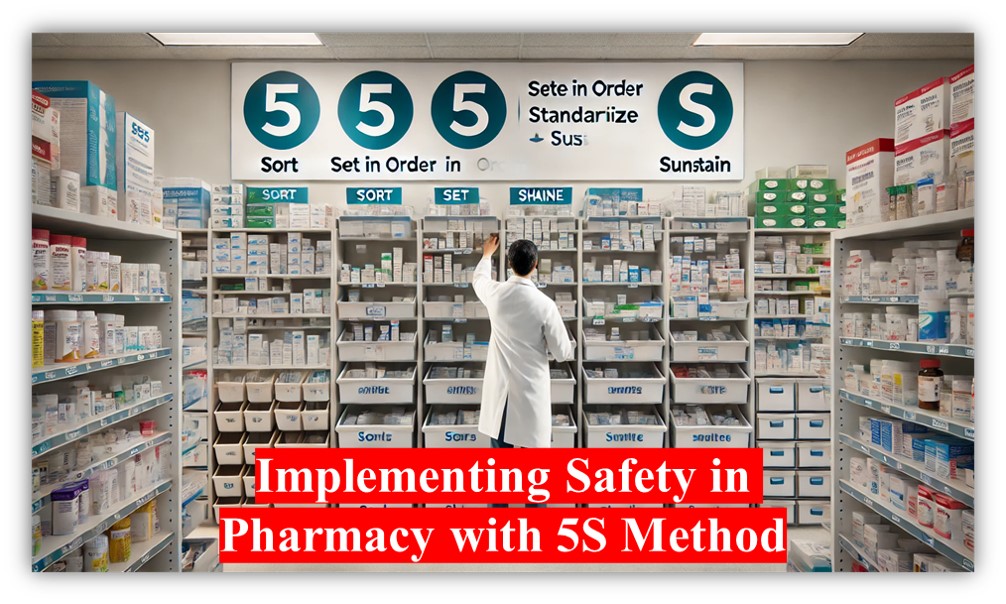The 5S methodology application in pharmacy settings has shown significant benefits in increasing operational efficiency, improving service quality, and promoting a better work environment for employees.
What is 5S?
5S is a workplace organization method designed to improve productivity, eliminate wastage, and optimize efficiency. 5S stands for:
- Sort (Seiri)
- Set in Order (Seito)
- Shine (Saisso)
- Standardisation (Saiketsu)
- Sustain (Shitsuke)

Benefits of 5S in Pharmacy
There are several major benefits of implementing the 5S methodology in a pharmacy setting:
Increased safety: Reducing clutter and organizing medications clearly can greatly reduce the risk of dispensing errors.
Improved efficiency: Employees can locate medications quickly, reducing time spent on tasks.
Cost savings: Streamlined processes reduce waste, lower inventory costs and reduce expired products.
Improved inventory management: Organized systems allow for more accurate stock management, reducing overstock or shortages.
Higher employee morale: A clean and organized workplace improves employee satisfaction, morale and engagement.
Steps to Implement 5S in a Pharmacy
Sort (Seiri)
Purpose:
Identify and remove unnecessary items from the pharmacy workspace.
Applications in the pharmacy:
- Check all medication shelves, drawers, and workspaces.
- Remove expired medications, infrequently used medications, and unnecessary equipment.
- Separate commonly used items from infrequently used items to streamline daily operations.
- Classify items based on frequency of use, with medications with high turnover closer to the dispensing area.
Result:
A cluttered space containing only the items necessary for the operation.
Set in Order (Seiton)
Purpose:
Organize items in a way that is easy to reach and workflow is efficient.
Applications in the pharmacy:
- Implement a standardized labeling system for medications, equipment, and tools.
- Assign specific locations for each item, with commonly used items in accessible areas.
- Create labeled storage for items such as syringes, pill counters, and IV bags.
- Organize medications by category or alphabetically to make retrieval efficient.
Result:
An organized pharmacy layout where each item has a designated place.
Shine (Seiso)
Purpose:
Clean the workspace and maintain hygiene standards.
Application in the Pharmacy:
- Follow daily cleaning routines for all surfaces, storage areas and equipment.
- Wipe down counters, shelves and pill trays to prevent cross-contamination.
- Schedule regular deep cleaning sessions for hard-to-reach areas.
- Inspect and clean machines and equipment such as pill dispensers, pill counters and refrigerators.
Result:
A clean and safe pharmacy environment that reduces the risk of contamination and infection.
Standardise (Seiketsu)
Purpose:
Develop standardized procedures for maintaining organization and cleanliness.
Application in the pharmacy:
- Document daily, weekly, and monthly cleaning checklists.
- Establish and post visual guides for storing, organizing supplies, and labeling medications.
- Implement protocols for handling expired or near-expiring medications.
- Regularly train staff on 5S principles and assign accountability for specific tasks.
Result:
Consistent and repeatable practices that all pharmacy staff can follow.
Sustain (Shitsuke)
Purpose:
Maintain and improve 5S practices over time.
Applications in Pharmacy:
- Conduct regular audits to ensure compliance with established 5S standards.
- Encourage employee feedback for continuous improvement of processes.
- Reward compliance with 5S practices to promote a culture of accountability.
- Provide refresher training sessions and update procedures as needed.
Results:
Long-term compliance with organized and efficient work standards that become part of the pharmacy culture.
Challenges in Implementing 5S in Pharmacy
- Resistance to change: Staff members may resist new protocols due to habits or comfort with existing methods.
- Initial time and cost investment: Implementing 5S may initially require time for training and organization, as well as costs for storage solutions or labeling systems.
- Maintaining consistency: Over time, pharmacies may struggle to maintain 5S standards without ongoing commitment.
- Customization needs: Each pharmacy has different inventory and workflow needs, so the 5S process should be tailored accordingly.
Key Points for Pharmacy 5S Implementation
- Initial planning: Successful 5S implementation begins with a solid plan that considers unique pharmacy needs.
- Staff involvement: Involve pharmacy staff at every step to reduce resistance and gain support.
- Continuous improvement: Maintain a culture of continuous improvement by regularly updating processes and gathering staff feedback.
- Leadership support: Ongoing support from pharmacy managers or hospital administration is essential to maintaining the 5S methodology.
Case Studies
- In an outpatient-emergency pharmacy, the application of 5S resulted in improved accuracy in medication dispensing and increased patient satisfaction rates.
- A hospital pharmacy that used a structured approach with 5S saw significant improvements in organization (217% increase) and cleanliness (138% improvement), leading to increased operational efficiency.

